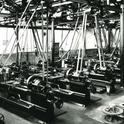A modern view of the Easter Rising in 1916: Things Remembered, Things Forgotten (Metempsychosis), 2005, by Daniel Clarke
A Nation and Not a Rabble: The Irish Revolution 1913-23 by Diarmaid Ferriter (Profile, £30)
Bitter Freedom: Ireland in a Revolutionary World, 1918-1923 by Maurice Walsh (Faber & Faber, £16.99)
Perhaps the greatest Irish myth is that we are a nation of rebels. It’s a comforting fiction whether you supported or opposed British imperialism. The rebellious Irish spirit has been invoked as an inspiration for Mahatma Gandhi and Indian nationalism. Yet in the 16th century, it excused the massacre of an irredeemably violent enemy. In 1580, Edmund Spenser justified a massacre of prisoners he had witnessed in County Kerry by saying: “the Irish themselves… were no lawful enemies, but rebels and traitors… There was no other way but to make that short end of them which was made.”
Diarmaid Ferriter rejects the rebel trope. The uses and abuses of national memory and the compromising of revolutionary ideals form the spine of his excellent history of the Irish revolution, A Nation and Not a Rabble. Ferriter, a professor at University College Dublin, is the outstanding young Irish historian of our time: robust, intellectually sophisticated and a master of the sources. Ahead of next year’s anniversary of the 1916 rebellion, Ferriter’s critique of national myth-making and his nuanced understanding of revolutionary motivation is timely indeed. Maurice Walsh, a former BBC foreign correspondent, examines the same period of Irish history in Bitter Freedom, but frames his narrative in the wider international context.
In modern Ireland there is a political scramble to clamber for the high ground of history. But contradictions abound. Is celebration or commemoration more appropriate for a revolution that failed to deliver a society “which championed all its children equally,” as the rebels’ 1916 proclamation declared, and that led to a civil war in which 2,000 people died? How should it be remembered in Northern Ireland, whose separation from the south gave the modern Irish Republican Army its raison d’être until the 1998 Good Friday Agreement?
Ferriter has no time for self-serving claims about which political party speaks most authentically for the ideals of dead patriots or for the frequent speculation about what they would have thought about the materialism and corruption of modern Ireland. Driving a coach and four through this blather, he recalls how one popular historian wrote that the financial crisis which erupted in 2008 would never have happened if the nationalist leader Michael Collins had been alive “because he was skilled in financial matters.” He recalls how the Irish Daily Star justified publishing naked pictures of Prince Harry, by saying it was acting in the spirit of “the men and women of 1916” (referring to the Easter Rising) in refusing to bow to the British monarchy. All of this, Ferriter writes, was a miserable substitute for “ensuring young Irish citizens… have a good understanding of what happened in 1916 and why.”
The writer Sean O’Faolain observed that post-independence Irish nationalism evolved into “a combination of realism, sentimentality and ruthlessness, in which each was always corrupting the other.” He was writing in 1947, more than two decades after taking part in the revolution which created the Irish state. His view is echoed in Ferriter’s analysis of a country still recovering from a financial and moral crisis spurred by endemic cronyism. He criticises the “dysfunction of an entire political culture,” in which “the practice of politics became about the spoils of the system rather than engagement with ideas about the nature of citizenship.”
Corruption in Irish public life has a long history. The 1801 Act of Union was accompanied by the gross outlay of state funds and favours to secure support from the Protestant ruling class whose ascendancy was being subsumed by Westminster. As Charles Cornwallis, the Lord Lieutenant, remarked: “My occupation is now of the most unpleasant nature negotiating and jobbing with the most corrupt people under heaven.” Crucially these negotiations still left the Catholic majority denied full civil and religious rights.
“O Ireland my first and only love / Where Christ and Caesar are hand and glove!”Another 19th-century legacy was most of the population’s aversion to violent radicalism. The savage repression of the great rebellion of 1798—as many as 30,000 were killed—traumatised the country. Revolts in 1848 and 1867 were smaller affairs, mainly significant in forming the consciousness of future revolutionaries. By the beginning of the 20th century most Catholics had put their faith in achieving Home Rule within the British Empire through their leaders in the House of Commons. The great battles over land and religion were won largely through constitutional politics.
The extraordinary mass movement led by charismatic leaders such as Daniel O’Connell and Charles Stewart Parnell created a society dominated by a conservative Catholic middle class—an aspiring nation of clerks, farmers and a standing army of clerics. The Church’s control of education was solidified under British rule, prompting these scathing lines from James Joyce in 1912: “O Ireland my first and only love / Where Christ and Caesar are hand and glove!” Although a cultural and sporting revival did create a new national consciousness, revolutionary politics still interested only a minority. So Ferriter, and Walsh in Bitter Freedom, go to considerable lengths to analyse why so many young men and women took up the gun after Easter 1916.
Growing fears over the Anglicisation of Ireland inspired a revolutionary minority. But as both Ferriter and Walsh illustrate, it was immediate circumstances that lit the fuse. In the summer of 1914, Ireland was on the verge of civil war as militant Protestants in the northeast, supported by the Tories, threatened to revolt if the government introduced Home Rule. Unionists imported guns from Germany and established the paramilitary Ulster Volunteer Force. British officers at the Curragh Camp in County Kildare resigned rather than face the possibility of enforcing Home Rule in Ulster; the Tory leader Andrew Bonar Law preached sedition to a mass rally in Belfast, telling the assembled thousands: “I can imagine no length of resistance to which Ulster can go in which I should not be prepared to support it.” So one may well ask, who were the real rebels?
Unionist mobilisation and the pusillanimous state response electrified militant nationalists. One of the most telling quotations in Ferriter’s account comes from the Cork nationalist Florence O’Donoghue. Responding to the Asquith government’s weak handling of the Curragh crisis, he asked: “Why did it surrender its authority and capitulate to the dictation of a group of serving officers and the unseen powers behind them?” Only the start of the war in August 1914 postponed the crisis as Irishmen of both faiths went to fight in France.
By 1916 the war was grinding on and a revolutionary minority saw the chance to strike. Yet the rebels who took up arms in the failed Easter Rising were jeered by crowds as they were led to prison. It took the executions of the leaders and the imposition of martial law to turn the public mood. When in 1918 the government rashly considered conscription to fill the trenches in France, the conditions were created for a Sinn Féin election victory and guerrilla war. As Ferriter writes: “The decisions that were made in the weeks following the Rising ensured that in the long term, the Rising came to be seen as the starting point for all subsequent Irish history.”
The revolutionary period saw the triumph not so much of one political group but of the imperative of stability. An essentially conservative polity forged by the conditions of the 19th century survived remarkably intact. While sentimentality still imbued official memorialisation of the past, and ruthlessness was the hallmark of the civil war, it was realism that shaped the modern state. This was nowhere more obvious than in the attitude of successive post-independence governments to re-unification: nationalist rhetoric hid a steely pragmatism. A southern cabinet minister advised northern nationalists to engage in “strenuous voluntary work” to improve their position under unionist rule. “The washing of southern hands could not have been more apparent,” writes Ferriter.
Maurice Walsh is a gifted writer with a novelist’s eye for the illuminating detail of everyday lives in extremis. Here he is describing the murder of a policeman in Tipperary in the author’s home county during the guerrilla war against the British state in 1919-21: “In Tipperary one of three policemen killed in an ambush was found lying in the middle of the road, ‘both eyes blown away and the lower part of his forehead—brain matter scattered on the road and a large pool of blood.’ Young men were pulled from the nearby creamery, beaten, and forced to kneel in the blood, kiss the road and say, ‘The Lord have mercy on the souls of the men we murdered this morning.’”
The great strength of Walsh’s book is its breadth of vision. His book challenges parochial tendencies in the revolutionary story. There is a poignant account of the Versailles negotiations where, on arrival, the Irish representative Sean O’Kelly “immediately sent a memo to the leaders of the peace conference informing them that he was the representative of the Provisional Government of the Irish Republic and requesting that Ireland be given a seat at the new League of Nations. There was no reply.” Another colonial subject pressing his people’s claim in Paris was the young Ho Chi Minh who, French police noticed, consorted with Irish nationalists. Walsh is also a humane narrator, especially in his treatment of the south’s Protestant minority. Relations with Catholics, he writes, are “characterised by mutual tolerance in public and curious incomprehension in private.”
Both Ferriter and Walsh stress the unpredictable nature of events during this period and the wide range of influences and personal motivations of the participants. I finished reading their books with a greater understanding of why many thousands, like my own grandparents, ultimately rebelled against the empire.
They are also important for anyone interested in the broader topic of separatism and contested identities. At a time of resurgent Scottish nationalism, I wondered again at one of the great “what ifs” of British and Irish history. What would have happened if Irish Catholics had been given full civil and religious rights and politically integrated when the Act of Union was passed in 1801? A revival of militant separatist politics might arguably have come about anyway, and the bitter sectarian enmities in Ulster would not have been easily attenuated. But the case of Scotland, integrated in the 18th century, shows the tantalising possibility of what a highly organised nationalist movement, focused on practical politics, can do without recourse to the gun.












